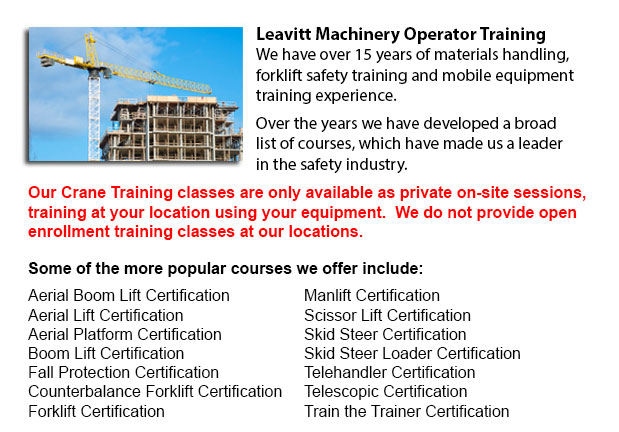
Crane Certification Regina - The Crane Certification Program covers the industry suggested content which would teach the safe and efficient operation of cranes. The person will train in the following: pre-operational, operational and post operating requirements; how to identify cranes and their component parts; how to determine overall lift capacity; rigging components and inspection/rejection criteria; and needs specific to the work location where the individuals training will be working.
Pre-operational requirements include assigning authority for the pre-operational check; performing the sequential pre-operational check based on the specifications certified by a professional engineer or manufacturer's specifications; checking the work area for obstacles and hazards; checking the log book for comments; checking hooks, chains, cables, crane movement and safety latches; making certain of the correct functioning of operational controls; and knowing how to make sure that the crane's disconnect switch/isolator is properly working.
The requirements to operating a crane will consist of the identifying of roles and responsibilities, and the determination of the need for a formal lift plan. The trainee will learn how to do danger assessments for the different environmental conditions, physical circumstances and workers. Subject matter consists of determining when to seek competent aid, the destination of loads and the safest route, and centre of gravity and load weight.
People training must be able to identify an over-capacity lift, in addition to be able to choose right rigging machine, choose load limits, and to determine the safe place for the crane to work from. Trainees would review both site-specific and universal crane signals for lifts, and methods for loading, traveling and lifting. Right maintenance practice will be included.
The individuals training will undergo an examination to test their knowledge of emergency response techniques for various situations, particularly electrical or mechanical failures. They would be asked to describe parking and shut down procedures for safety and security, to follow tagging and lock out procedures, and to explain why near misses are recorded and reported to the appropriate person. Log book records should be maintained.
Trainees would develop knowledge of rigging, particularly, establishing who has authority and responsibility for rigging, identifying different kinds of rigging, knowing storage procedures and load capacity ratings.
Post-operational requirements comprise entering defects or deficiencies, maintenance and service history within the log book, according to provincial, federal and state codes requirements.
Site-specific requirements can be incorporated into the safety training program based on the employer's requirements.
-
Forklift Training Classes Regina
Forklift Training Classes Regina - Forklifts are a kind of heavy lifting equipment used in order to move and handle material efficiently and safely. Sometimes called Lift Trucks, they are made use of in different industries. Employees working with an... More -
Telehandler Training Courses Regina
Telehandler Training Courses Regina - Employers are responsible for making sure that their operating personnel and supervisors are trained to work proficiently utilizing telehandler machines. The competence level of employees need to be assessed. If... More -
Operator Safety Training, Re-Qualification Training, In-House Instructor Training in Regina
Lift trucks are utilized in just about all industrial construction sites and in warehouse operations and in boat yards. The reach feature of a lift truck is a very important component utilized in a variety of applications like for instance when a she... More -
Heavy Equipment Operator Training Regina
Heavy Equipment Operator Training Regina - Training facilities that offer good standards in the business and not only provide field performing tasks but additional equipment training are highly sought after. Accredited schools offer students the know... More -
Wheel Loader Operator Training Regina
Wheel Loader Operator Training Regina - Cranes are industrial machines which make use of pulleys or levers so as to lift considerable loads. The Roman people utilized cranes in order to put up big monuments, that means these machines have been existi... More -
Crane Safety Training Regina
Crane Safety Training Regina - Both crane driver as well as their supervisors need to know all the possible problems connected to the operation of an overhead crane. All over North America, there is legislation that provides regulation for the safe o... More -
Scissor Lift Safety Training Regina
Scissor Lift Safety Training Regina - A Scissor Lift is a functional kind of platform that normally moves in a vertical direction. The machinery is capable of this movement due to the use of folding supports that are linked in a criss-cross pattern c... More -
Forklift License Regina
Forklift License Regina - Acquiring a forklift certification or forklift license within North America would require the one training to carry out hands-on training in addition to classroom instruction. The state, provincial and federal regulatory bod... More

Forklift Training Regina
TOLL FREE: 1-888-254-6157
Regina, Saskatchewan
forklifttrainingregina.com
Email Us
About Us



